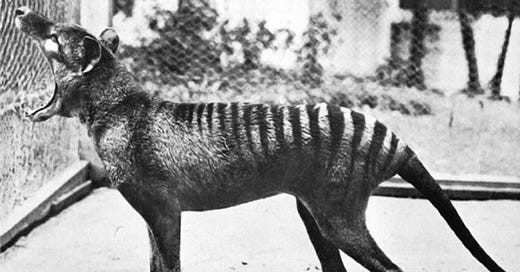Has anybody seen a Tasmanian tiger lately?
He had fair warning and he got what was coming to him
“Has anybody seen a Tasmanian tiger lately?” The answer to the question posed by The Examiner in February 1937 has been a matter of dispute. Reports of the animal followed for several decades, numbering in the hundreds or thousands. For many years, a park ranger in Far North Queensland was too embarrassed to report an animal he spotted some time in the 1980s.
It’s not hard to understand why. “I represent 3,000 people who have been told they’re nuts, basically,” a curator of a Tasmanian Tiger sightings page told The Guardian in 2016.
The Hobart Zoo was well aware that Benjamin was a rarity. But no one, it seems, knew precisely how rare. The thylacine, was, by all accounts, a healthy and lively animal. His route to captivity – like many of the details around his life – is a matter of some dispute. What is known is that he arrived in the early 1930s.
He was fairly typical of the species: long and slender, with a patch of tiger-like stripes converging into a tapered tail, reminiscent of a much closer relative, the kangaroo. Australian naturalist David Fleay captured the final 45 seconds of filmic evidence of the marsupial – a task that earned him a bite on a butt check. Benjamin gave a pair of warning “yawns” captured on video, before piercing his flesh.
“The animal managed to get behind him and bite him on the buttocks,” a museum curator would explain later. “He had fair warning and he got what was coming to him.”
Filmed in 1933, the footage captures several behaviors that earned the species the also common Tasmanian wolf name. He circles his pen, sniffs at the air, scratches his side with a hind leg and tears into a piece of meat. One would be forgiven for assuming they were witness some strange breed of dog.
Unaware that Benjamin was the last captive thylacine, the zoo failed to report his death to the press. An otherwise healthy animal, his demise is believed to have been a product of neglect. Locked out of his sleeping area, he spent the uncharacteristically cold Tasmanian night in September 1936 on a slab of concrete and was dead by morning. Less than two months prior, the species finally achieved protected status from the Tasmanian government.
A week after Benjamin’s death, the Hobart city council set aside £30 for the procurement of a replacement thylacine.
No replacement was ever found.
Having already vanished from mainland Australia some 2,000 years prior, the species was hunted into extinction in Tasmania by the late-1930s. The government issued more than 2,000 £1 bounties for the animal, believing it to be responsible for the death of livestock. While farmers blamed the thylacine for the widespread disappearance of sheep, subsequent research has determined that the carnivorous marsupial’s jaws were too small and weak to take down anything larger than a possum.
A 1921 photo snapped by Henry Burrell of the animal carrying a chicken in its mouth contributed substantially to its reputation as a notorious poultry thief. The newspaper that first ran the photo conveniently cropped out clear indicators that the image had been taken in captivity where a chicken – alive or dead – would have been a far easier conquest.
Like the kangaroo, Tasmanian tiger was capable of bounding on its two hind legs when startled, as it often did will crossing the road. But its build left the marsupial unable to run at high-speeds, making it a far easier target than the dingo, which was likely responsible for the slaughter of far more livestock.
Fifty years after Benjamin’s death, the thylacine was finally declared extinct by the Tasmanian government. Three years prior, media magnate Ted Turner kicked off a yacht race from Sydney to Hobart by stating, "If anyone can produce evidence that the Tasmanian Tiger is still alive and well, I will give them $100,000 reward.”
Subsequent media outlets have issued rewards in the millions. To date, none have been forthcoming.
Sources:
Tasmanian tiger sightings: 'I represent 3,000 people who have been told they’re nuts' https://www.theguardian.com/environment/2016/dec/01/tasmanian-tiger-sightings-i-represent-3000-people-who-have-been-told-theyre-nuts
The obsessive search for the Tasmanian Tiger https://www.newyorker.com/magazine/2018/07/02/the-obsessive-search-for-the-tasmanian-tiger
Tasmanian tiger's jaw was too small to attack sheep, study shows https://www.sciencedaily.com/releases/2011/08/110831210058.htm
Last Tasmanian Tiger, Thylacine, 1933 https://www.youtube.com/watch?v=6vqCCI1ZF7o



